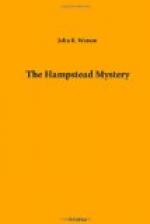Inspector Chippenfield hesitated a moment as if in deep thought. The object of his hesitation was to give Flack an opportunity of imparting any information that had come to him while on guard. The inspector believed in encouraging people to impart information but regarded it as subversive of the respect due to him to appear to be in need of any. As Flack made no attempt to carry the conversation beyond the state of his health, Inspector Chippenfield came to the conclusion that he was an extremely dull policeman. He introduced Flack to Detective Rolfe and explained to the latter:
“Flack was on duty on the night of the murder but heard no shots. Probably he was a mile or so away. But in a way he discovered the crime. Didn’t you, Flack? When we rang up Seldon he came up here and brought Flack with him. He’ll be only too glad to tell you anything you want to know.”
Rolfe took an official notebook from a breast pocket and proceeded to question the police-constable. The inspector made his way upstairs to the room in which the crime had been committed, for it was his system to seek inspiration in the scene of a crime.
Tanton Gardens, a short private street terminating in a cul-de-sac, was in a remote part of Hampstead. The daylight appearance of the street betokened wealth and exclusiveness. The roadway which ran between its broad white-gravelled footwalks was smoothly asphalted for motor tyres; the avenues of great chestnut trees which flanked the footpaths served the dual purpose of affording shade in summer and screening the houses of Tanton Gardens from view. But after nightfall Tanton Gardens was a lonely and gloomy place, lighted only by one lamp, which stood in the high road more to mark the entrance to the street than as a guide to traffic along it, for its rays barely penetrated beyond the first pair of chestnut trees.
The houses in Tanton Gardens were in keeping with the street: they indicated wealth and comfort. They were of solid exterior, of a size that suggested a fine roominess, and each house stood in its own grounds. Riversbrook was the last house at the blind end of the street, and its east windows looked out on a wood which sloped down to a valley, the street having originally been an incursion into a large private estate, of which the wood alone remained. On the other side a tangled nutwood coppice separated the judge’s residence from its nearest neighbours, so the house was completely isolated. It stood well back in about four acres of ground, and only a glimpse of it could be seen from the street front because of a small plantation of ornamental trees, which grew in front of the house and hid it almost completely from view. When the carriage drive which wound through the plantation had been passed the house burst abruptly into view—a big, rambling building of uncompromising ugliness. Its architecture was remarkable. The impression which it conveyed was that the original builder had been prevented by




